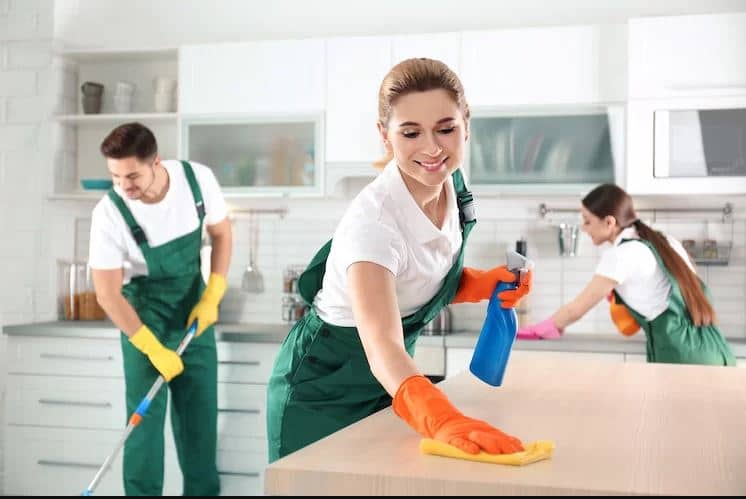The Step by Step Process of Post Construction Cleaning
As the final nails are driven in and the construction dust settles, the next step for any commercial or residential property is post-construction cleaning. This process goes beyond just improving appearance; it helps create a safe and healthy environment by removing construction debris, allergens, and potential hazards left behind.
In this blog, we’ll outline the step-by-step process of post-construction cleaning, including the essential tools you’ll need, necessary precautions, and effective strategies for tackling each cleaning task.
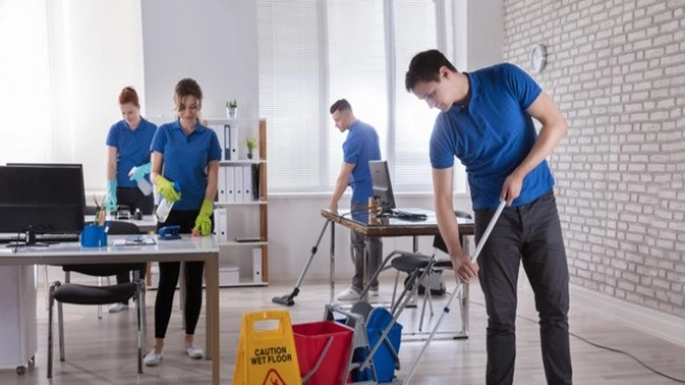
Key Takeaways
Collect tools such as a vacuum cleaner, brooms, mop, scrub brush, and protective gear to ensure efficient post-construction cleaning.
Approach hazardous materials with caution; prioritize ventilation and use appropriate protective equipment like gloves and dust masks.
Start by preparing the area; clear away debris using brooms, vacuums, and dusting tools.
Remove any remaining dust, perform a thorough deep clean, address the walls, ceiling, and windows, mop the floors, clean the air vents, and pay attention to the exterior.
Essential Equipment and Products for Post-Construction Cleaning
Properly equipping yourself for post-construction cleaning is crucial for ensuring both efficiency and safety. Here’s a breakdown of the equipment and products you'll need, along with essential personal protective gear:
Cleaning Equipment and Products
- Vacuum Cleaner: A versatile tool with various attachments to effectively remove dust and debris from different surfaces.
- Brooms and Dustpans: Perfect for sweeping up larger debris like wood chips or broken glass.
- Mop and Bucket: Essential for cleaning hard floors, especially those with stubborn stains or grime.
- Scrub Brush: Effective for tackling tough dirt or grime on surfaces like tile grout or bathroom areas.
- Cleaning Cloths and Towels: Have a variety on hand, including microfiber cloths, rags, and paper towels for various cleaning tasks.
- Cleaning Solutions: Collect different solutions tailored for specific surfaces and types of dirt, such as a degreaser for kitchens or a glass cleaner for windows.
- Protective Gear: Prioritize safety by wearing gloves, safety glasses, and respirators if needed to protect yourself during the cleaning process.
- Ladders: Necessary for reaching high areas like ceilings or light fixtures.
- Trash Bags: Heavy-duty bags for efficient disposal of debris and waste.
- Sponges and Scouring Pads: Useful for a range of cleaning tasks, such as scrubbing countertops or removing tough stains.
Personal Protective Equipment (PPE)
Safety should always be your top priority when cleaning a construction site. Here’s a list of PPE to consider:
- Rubber-Soled Shoes: Closed-toe shoes with rubber soles help protect against sharp objects and potential hazards.
- Rubber Gloves: Safeguard your hands from chemicals and sharp materials.
- Dust Mask: Protect your lungs from harmful dust and debris during the cleaning process.
- Goggles or Eye Protection: Shield your eyes from irritants or injuries caused by debris and cleaning agents.
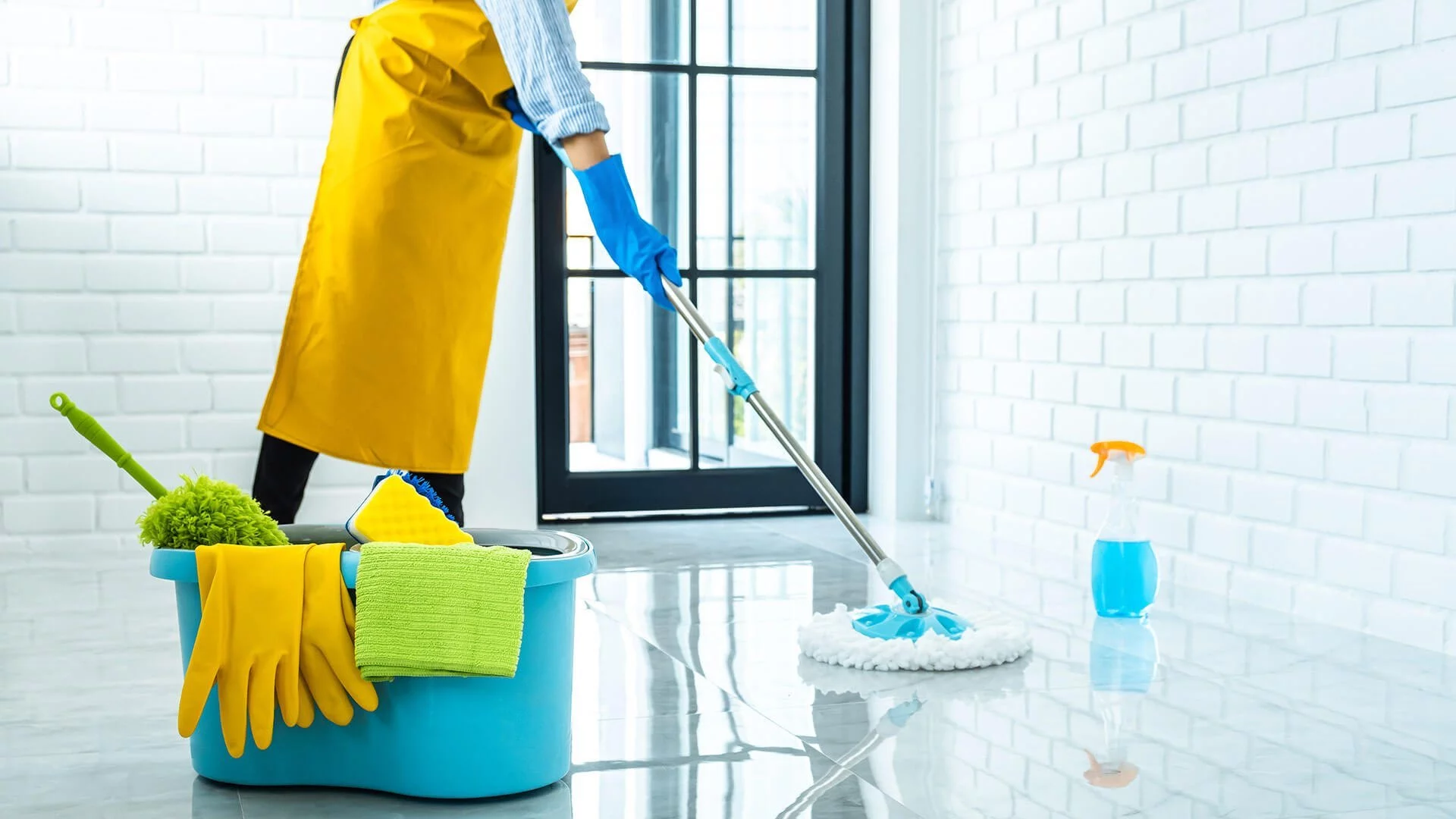
Precautions for Post-Construction Cleaning
Safety is paramount during the post-construction cleaning process. With potentially hazardous materials and sharp objects around, it’s essential to take precautions. Here’s how to stay safe:
Identify Hazardous Materials
Before you begin cleaning, be vigilant for substances like asbestos, lead, mold, and other toxic materials. Handle them carefully and follow the proper procedures.Ensure Proper Ventilation
Maintain good airflow, especially when using chemicals. Open windows and doors to allow fresh air in and ensure adequate ventilation in the cleaning area.Use Chemicals Safely
Always read and adhere to the instructions on your cleaning chemicals. Wear appropriate protective gear, avoid mixing different chemicals without proper knowledge, and store them safely away from heat sources and flames.Be Cautious with Sharp Objects
Exercise caution around sharp items like nails and broken glass. Handle them carefully, and consider using a magnet to collect small metal pieces.Use Ladders Safely
If you need to use a ladder for high areas, ensure it’s stable and placed on a secure surface. Avoid overreaching and refrain from standing on the top rungs.Dispose of Waste Properly
Follow local regulations for waste disposal. Keep it straightforward: don’t mix different types of waste, label hazardous materials clearly, and store them securely until they can be disposed of safely.
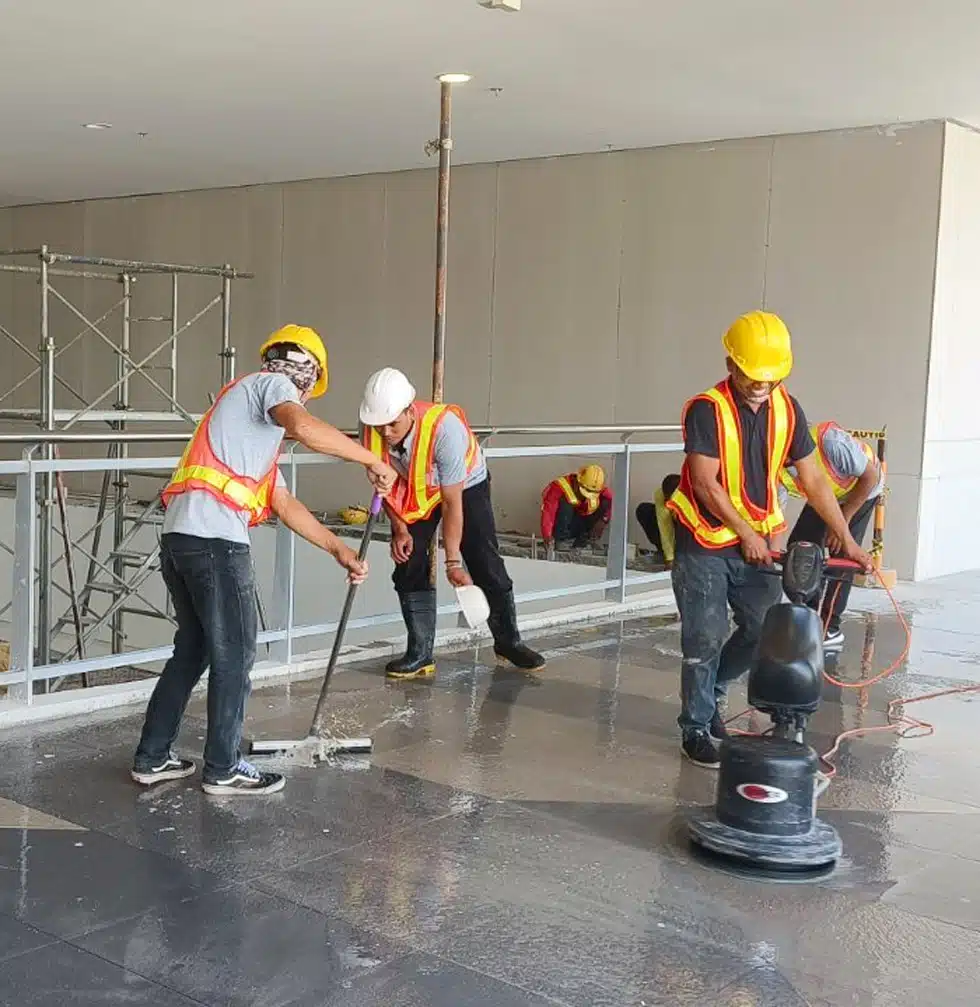
The Step-by-Step Process of Post-Construction Cleaning
With everything in place, it’s time to dive into post-construction cleaning. We’ll guide you through each step to transform your new space from construction chaos to a sparkling clean environment.
Step 1: Prepare the Area
A little organization goes a long way. Start by cleaning from the farthest point, working from top to bottom and inside to outside, ensuring that dust and dirt are consistently directed outdoors. Make the area as dust-free as possible before intensive cleaning. This not only simplifies the final task but also promotes your well-being. Seal off unaffected rooms with plastic sheeting (available at your local hardware store) and secure it with masking tape. Remember to block vents and openings with extra plastic sheeting to protect your HVAC system.
Step 2: Clear the Path
In this phase, focus on removing all debris and dust left over from the construction process. This includes both large items, such as construction materials, and finer dust particles settled on surfaces like floors, walls, and décor. Use a combination of brooms, vacuums, and dusting tools to meticulously clean the area, clearing space for deep cleaning later on. Efficiently dispose of waste using wheelbarrows or dumpsters, or consider hiring professional debris removal services for larger items. For smaller debris, use a vacuum equipped with a HEPA filter to capture tiny particles and dust.
Step 3: Remove Residual Dust
Now it’s time to tackle everything from stickers on doors to mortar and plaster residues, excess grout, and various types of dust.
Drywall and Plaster Dust
Mix 2 cups of white vinegar with a gallon of warm water to create a cleaning solution. Mop small areas gently, keeping them as dry as possible, and quickly dry them with a towel. Repeat this process until your surfaces shine, changing the solution when it becomes cloudy.
Brick and Mortar Dust
Brick dust is heavier and requires extra care. Start by vacuuming with a powerful nozzle, then dilute 1.5 cups of hydrogen peroxide in a gallon of water. Use soft cotton rags to wipe hard surfaces, being careful not to press too hard to avoid scratches. For soft surfaces like carpets, use a stiff-bristled brush to scrub away the dust, and avoid wetting brick dust on these surfaces to prevent staining.
Spackling Paste
To remove spackling paste without damaging surfaces, use a plastic putty knife. For tiles, wet the paste to soften it before scraping, then wipe clean. On wood surfaces, apply wood oil to soften the paste before scraping. For carpets, let the paste dry completely, break off as much as possible, and then use a carpet cleaner.
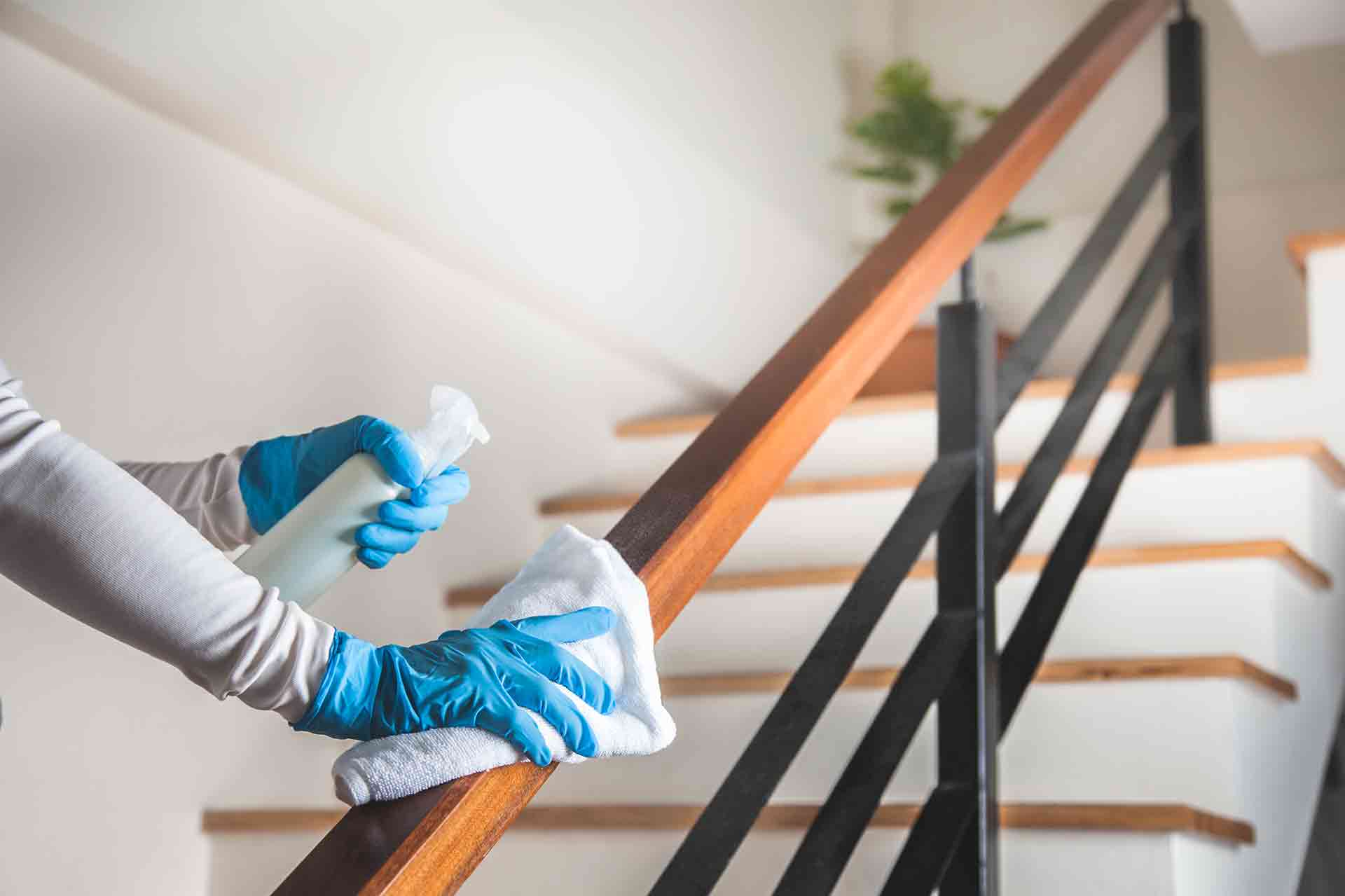
Step 4: The Deep Clean
Now that the heavy lifting is complete, it’s time for a thorough deep clean to ensure every corner shines. You can tackle this the day after the rough clean or jump right in if you're ready. Here’s your checklist for each room:
Kitchen
Try to avoid cooking for about a week after this deep clean. Here’s what to focus on in the kitchen:
- Dust the tops of cabinets, countertops, shelves, ceiling fans, and door and window frames.
- Deep clean the interiors and exteriors of cabinets and drawers.
- Clean appliances inside and out.
- Scrub sinks and faucets.
- Wipe down countertops, backsplashes, and walls.
- Clean light switches and fixtures.
- Vacuum air vents.
- Vacuum and mop the floor.
- Use a degreaser on the sink and stovetop.
Bathrooms
Prioritize sanitation to ensure it’s ready for use:
- Remove any marks or paint stains from walls and baseboards.
- Deep clean and disinfect all surfaces.
- Vacuum and mop the floor.
- Clean cabinets and drawers inside and out.
- Clean windows and glass surfaces.
- Wipe down doors, including doorknobs and frames.
- Clean light fixtures.
- Polish stainless steel surfaces.
- Disinfect exhaust fans, filters, and ventilation grills.
- Remove all trash.
Other Interior Rooms
Apply this checklist to any additional rooms in the house:
- Dust cabinets, shelves, ceiling fans, and door and window frames.
- Deep clean the interiors and exteriors of closets, cabinets, and drawers.
- Clean walls, windows, and baseboards.
- Wipe down light switches and fixtures.
- Vacuum air vents.
- Vacuum floors.
- Mop hard floors.
Step 5: Clean the Walls, Ceiling, and Windows
Next, focus on vertical spaces, starting with the ceiling. Use a long-handled mop and your preferred cleaning solution. Mop side to side for a thorough clean, ensuring all dust is removed. To tackle construction dust, use a sponge or soft-bristled brush, followed by a damp cloth with soapy water, rinsing regularly for a spotless finish. Pay special attention to corners and light switches.
For the walls, use a damp cloth with soapy water. Start by cleaning dirt from crevices with a sponge or soft-bristled brush. Rinse your cloth often to ensure all soap is removed, paying extra attention to corners and detailed areas where dust may linger.
For the windows, use a damp soft rag to remove dust, then follow up with a streak-free glass cleaner for a crystal-clear finish. These simple steps will leave your walls, ceiling, and windows sparkling, completing your post-construction cleaning efforts.
Step 6: Mop the Floors
Once the construction crew is gone, your floors might look a bit rough, but restoring them is easy.
Ceramic Tile Floors
Ceramic tiles need more than just a rinse. Start by vacuuming, then mix warm water with a mild cleaner in a bucket. Mop with a microfiber mop, avoiding sponge mops as they struggle with grout lines. Use a circular motion for a thorough clean.
Hardwood Floors
Dust hardwood floors with a floor brush attachment on your vacuum cleaner to avoid scratches. Mop with warm water using a soft towel. For an extra shine, apply a wood polishing product after the post-construction clean to help repel dust.
Carpets and Rugs
Begin by vacuuming with a new filter bag at the highest power setting for maximum effectiveness. Since we’re dealing with dust, avoid washing the carpets, as this can worsen the situation. If not done properly, dust can turn into stubborn dirt, necessitating professional carpet cleaning.
Laminate Floors
Laminate flooring is durable. Dust, sweep, or vacuum without using abrasive attachments, similar to hardwood floors.

Step 7: Clean Air Vents and Replace Filters
After a renovation, dust can easily accumulate in air vents, impacting the air quality in your home. Whether your project spanned the entire house or just a section, taking care of your air vents is essential for maintaining fresh indoor air.
Here’s what to do: Remove the vent covers from the walls and ceilings, wash them with soap and warm water, and allow them to air dry completely. Before reinstalling the covers, replace any exposed air filters with new ones. This step goes beyond just cleanliness; it ensures that the air circulating in your home is as fresh as your newly renovated space. Neglecting this can lead to allergies or respiratory problems, so take a moment to keep the air flowing clean and clear.
Step 8: Revive the Exterior
As you finish the interior transformation, don’t overlook the exterior; it’s time for some outdoor TLC. Here’s a straightforward checklist for your post-construction outdoor cleaning:
Remove Debris
Start by clearing any leftover construction materials from the yard, garage, or other outdoor areas. Get rid of nails, screws, sawdust, and other miscellaneous items.
Wash Exterior Walls
Use a pressure washer to rejuvenate your exterior walls. Blast away dirt, dust, and debris to uncover the true beauty of your outdoor surfaces.
Windows
Let the light shine in! Clean all windows thoroughly with a reliable glass cleaner for a sparkling finish.
Gutters
Ensure proper water flow by cleaning out the gutters. Remove any debris and check for potential damage.
Walkways and Driveways
Sweep away the remnants of the construction process from walkways and driveways. A clean path sets the tone for your refreshed space.
Patios and Decks
Sweep patios and decks, then use a pressure washer to eliminate any lingering dirt and debris.
Fences and Gates
Your pressure washer will come in handy here as well. Give fences and gates a thorough cleaning to restore them to their former glory.
Wrapping Up
And there you have it—the final touch in your post-construction cleaning journey! Your space has successfully shed the remnants of construction, transforming into a clean and welcoming canvas ready for the next chapter.
We understand that amidst the excitement, certain tasks may have felt overwhelming. That’s where First Cleaning Services comes in to lend a helping hand. Our team of professional, vetted cleaning experts is dedicated to meticulously handling every aspect of post-construction cleaning, allowing you to enjoy the thrill of moving into your new space without the hassle of cleaning! Booking our services online is quick and easy—you won’t regret it.
Frequently Asked Questions
Always wear appropriate protective gear, including gloves, safety glasses, dust masks, and, if necessary, respirators. Closed-toe, rubber-soled shoes are crucial for protecting against hazards like broken glass and nails.
Post-construction cleaning involves more than regular cleaning; it requires additional skills and specialized tools. Tasks may include using wet and dry vacuums, commercial floor polishers, steam cleaners, and shop vacuums. While you can rent these tools, it's wise to hire cleaning professionals if you're unsure how to use them.
Rough Cleaning
This stage focuses on removing visible debris such as dust, paint overspray, adhesives, and masking materials. It includes thorough vacuuming, dusting, and mopping.Thorough Cleaning
This step revisits tasks from the first stage, concentrating on interior surfaces with microfiber cloths and neutral cleaners for a residue-free finish.Touch-Up Cleaning
This meticulous phase addresses fine details and is typically performed a few days after the second cleaning to catch any remaining settled dust or dirt.





